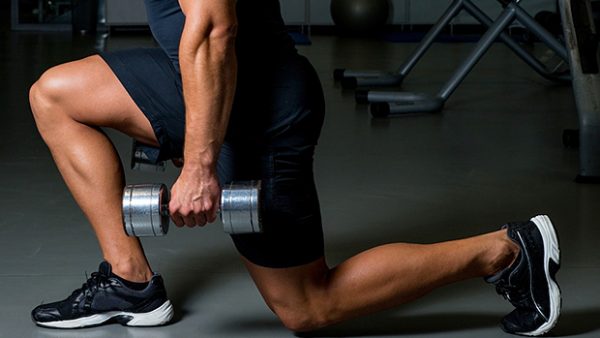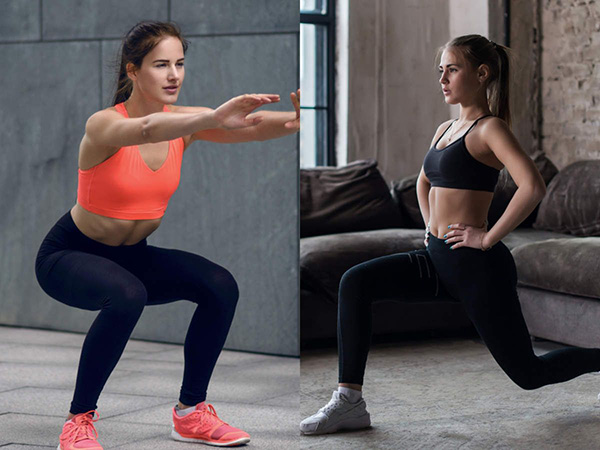Lunges are a multi-joint exercise designed to work out the lower body. It is used both in strength training complexes and in the formation of a beautiful relief of the legs.
Which muscles work
The hamstrings and calves also receive a load. The abdominal muscles are indirectly involved.
With the help of lunges, stabilizers are worked out that are responsible for body balance and coordination of movements: the anterior tibials, back extensors, trapezius, scapula lifters, small and middle gluteal muscles.
The benefits of lunges
The popularity of the exercise is due to many advantages:
- Development of strength characteristics . Lunges with additional weights are used in strength training as a way to emphasize the development of the hips.
- Improving the relief . Fast lunges with your own weight or with minimal loads help to achieve high-quality “drawing” of the leg muscles.
- Development of coordination . By simultaneously working out several stabilizing muscles, the athlete improves the sense of balance and agility.
- Strengthening problem areas . Girls use lunges to work the inner thighs, improving the appearance of the legs.
- Weight loss . The exercise simultaneously engages the large muscles of the body, which forces the body to spend a large number of calories to provide energy.
- Workout the glutes . By changing the technique of the exercise, the athlete can shift the emphasis of the load from the hips to the buttocks, achieving an increase in their volume.
- Stretching. Deep lunges in different directions give the athlete the opportunity to improve leg stretch and hip joint mobility.
In addition to the above, classic bodyweight lunges can be an excellent substitute for squatting with a barbell if you have problems with the spine.
Back and forth lunges
The most popular variation of the exercise is the classic forward lunges. They are used by both professional athletes and beginners. Technique of execution:
- Stand up straight and press the brushes to the belt.
- Inhale, step forward and at the same time lower the pelvis.
- In the lower position, the knee joints of both legs should be at an angle of 90 °.
- We linger for a couple of seconds, and then, with exhalation, we also smoothly return to the vertical position .
- Repeat the exercise starting with the other leg.
At first, you will feel a little wobbly. Therefore, until the muscles get stronger, perform lunges without additional weights.

balance, we recommend using the Smith machine. The technique of lunges in this machine is as follows:
- We get into the machine, remove the sliding bar from the stops and press it against the trapezius muscle (upper back).
- Put one leg forward, take the other back. The distance between the feet should be about 60–70 cm.
- Inhaling, we gradually descend to a right angle in the “front” knee.
- We linger for a couple of seconds, and then, exhaling, in the same way smoothly return to the starting position.
- Do 10-12 squats, change legs and repeat.
The bar is fixed to the rails, so you can safely lunge while strengthening your thigh muscles.
If you experience pain in the knee joint, replace the classic lunges with reverse ones. The only difference is in technique: the leg is not retracted forward, but backward.
Once you have mastered simple and reverse lunges without weight, gradually add weights. Start with light dumbbells in each hand (2-3 kg) or small weights. If you are confident in your abilities, do the exercise with an empty bar on the shoulders.
General recommendations for the considered variations:
- do not slouch or round your back;
- do not extend the front knee beyond the toes;
- slightly turn the toe of the “back” leg inward;
- in any variation, do not place the “back” knee on the floor;
- do not lean forward too much;
- keep your head straight;
- if you cannot keep your balance, grasp the support with one hand.
Lunges using the platform
Let’s start with the” Bulgarian “attacks. The variation involves the use of a high support for the hind leg. Technique:
- Stand with your back to the bench.
- Perform a wide step with the right foot. The distance between the feet is 70–80 cm.
- Raise the left leg and put it toe in the seat.
- Cross the forearms at chest level.
- While inhaling, gradually lower the body as low as possible (for beginners, it is permissible to squat to a right angle in the “front” knee).
- Hold for a second, then as you exhale, rise up as smoothly.

Thanks to the high “back” foot, body weight is essentially shifted to the “front “The leg, which increases the load on the quadriceps, buttocks and hamstrings.
Recommendations:
-
- Use your“ working ”leg to rest on the heel;
- do not extend the knee beyond the foot;
- while rising, do not straighten the knee joint to the end;
- do not rest in the upper phase;
- keep the lower back arched;
- to increase the load, instead of a solid support, use a fitness ball or TRX-loops.
Now let’s look at another use of platforms. With a low stand, you can perform wide lunges for the buttocks. The technique is simple:
- We select a low platform (15–20 cm). We take dumbbells in our hands and stand on a support.
- Keeping our back straight, inhale, pull our right leg back as much as possible and put it toe on the floor.
- In the lower phase we linger for a second, and then as you exhale, we smoothly return to the starting position.
- Repeat with the left leg.
In this exercise, the muscles of the buttocks work more efficiently than with ordinary reverse lunges, since due to the rise the supporting foot increases the stretching of the entire back of the thigh.
Recommendations:
- when abducting the “back” leg, keep the “front” shin upright;
- slightly tilt the body forward, but do not round your back;
- do not perform the element from a high platform (for example, from a bench), it can be dangerous.
Lateral lunges
Exercise allows a good load on the outside of the quadriceps and buttocks. It also strengthens the inner thighs and improves leg stretch. Let’s start with a simple technique for beginner athletes:
-
- We stand up straight and spread our feet wide (80–100 cm). We put our hands on the waist.
- While inhaling, we shift the body weight to the side and move the pelvis back, as if we are sitting on an imaginary chair.
- As we exhale, we return to the starting position.

Cross lunges
The exercise is similar to reverse lunges. The difference is that the leg that is pulled back “goes” beyond the line of support. Thanks to this, the muscles of the buttocks are stretched at an unusual angle and are effectively worked out. Technique:
- Stand up straight, feet shoulder-width apart.
- Inhale and take the right foot back,
- behind the left.
- At the same time, lower the pelvis to formation of a parallel between the thigh of the supporting leg and the floor.
- Hold for a second and, with an exhalation, return to the starting position.
- Repeat with the left leg.
Comparison of lunges with squats
The technique of lunges is based on a shift in body weight by one leg, which allows you to use stabilizers and emphasize the load on the hips and buttocks. But, since the exercise is performed, in fact, with one leg, it will not be possible to take a lot of weight in your arms or shoulders. Therefore, even power lunges will not help increase overall body weight.
Squats are another matter. They are performed with equal support on both feet, which allows you to gradually increase the load. Because of this, strength squats stimulate the production of hormones responsible for muscle growth throughout the body.
We recommend combining both exercises in one training. Squats – to increase strength and gain in total body weight, lunges – to work out the relief of the hips and buttocks.

